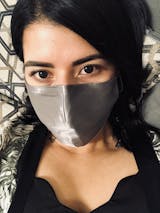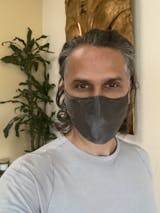Our skin always needs protection, no matter what season it is. But the products we use are going to vary based on how the weather affects our skin. We’re coming into a seasonal change. Winter has left us, and while we’re very much in the middle of Spring according to the month we’re in, much of the US is heating up faster than a Texas grill (hello, climate change?). So it’s really important to be clued into how your skin is reacting to the weather, and start preparing for change as it happens. What was working for your skin in Winter is likely not going to work for your skin in Summer.
That’s not to say that you need to change your entire skin ritual. Our skin is still the same skin, after all. So keeping some of the same products makes sense. But making small tweaks and adjustments to the products you use, and the way you use them as the seasons come and go can make a world of difference to how your skin will look, feel, and behave.
I know what you’re thinking… Sounds like a lot of effort, and a lot of cost!
Au contraire! Adjusting your skin regime doesn’t need to be complicated, nor does it need to be expensive. It can be as simple as adding, or swapping out just a couple of your products to satisfy your skin’s needs.
Which Products Should You Consider Switching in Your Skincare Ritual?
If you find that the past season’s skincare ritual is just not doing your face any justice anymore, try adjusting these two products:
- Your moisturizer. Some of us get very attached to our skincare products—and rightly so! It can be a royal pain in the butt trying to find products that you love the smell and texture of, the ingredients, the brand—and products that actually work for your skin. But going from a thick, nourishing cream in the Winter time, to a lighter, skin balancing cream when the weather warms up, is a classic example of making a small, but impactful switch to your regime.
- The other item you can swap out are your serums. Now, I know that not everyone uses a serum in their ritual. Why? I have no idea. These little babies are so packed full of amazing skin benefits, they’re the holy grail to any ritual, and we should all be using them for all seasons, and all reasons.
What the Heck Are Serums?
Basically, serums are highly concentrated liquids that are designed to target specific skin concerns. They can be gel-like, oily, or even a little creamy. The consistency really depends on the ingredients, which are often very minimal.
These potent little potions are used as a treatment in your ritual. Pigmentation? Yep! Fine lines? You betcha! What about acne-prone skin? No problem!
Another great thing about serums is, they can be mixed and matched with other serums and products, so if you want to combat your enlarged, clogged pores, fine lines, and the pigmentation on your cheeks, you can use a different serum for each of those concerns—at the very same time!
My favorite part about serums is, because they don’t normally contain many ingredients, they are able to penetrate the skin much faster, and often deeper than any of your other products, which is why they truly are ahhh-mazing!
Here’s What a Typical Ritual Looks Like:
- Cleanser
- Eye Cream
- Toner
- Serums
- Moisturizer (cream)
We all perform our skincare ritual in this general order, likely because an esthetician once told us to, or we read it somewhere, right?
Serums are always added into the ritual before the moisturizer. Why is this? Well, due to a serum’s simplified liquid-like state, it can travel easier, and more deeply into the skin than a cream can. Because they also contain less ingredients at a higher concentration, they are able to target specific skin concerns more effectively.
Moisturizers (creams) generally contain more ingredients than serums. Sometimes these ingredients are active, meaning they can target certain surface skin conditions. But they normally contain larger sized molecules, which means that they cannot penetrate the layers of the skin past a certain depth. This also means it stops anything that is placed on top of the cream from also penetrating deeper into the skin. Moisturizers act more like a barrier to retain hydration, nutrients and moisture within the skin, which is why we apply it as the last step in a regime (1).
It’s important to use a moisturizer in the final step of your ritual, as this will “seal in” your other products. Without a moisturizer, your other products, like your wonderful serums, can evaporate and escape the skin throughout the day or night, making them less effective, and it will leave your skin open to damage from nasty things like free radicals, sun damage, and environmental pollution. So always finish off your regime with a moisturizer.
For those of you who don’t know, free radicals are the collective term given to atoms that break down our skin’s collagen. While our bodies do naturally produce free radicals in small amounts, the external free radicals that come from pollution and other environmental factors wreak havoc on our skin’s health (2). They are responsible for most of our wrinkles, fine lines, dark spots, blemishes and sagging skin. Using a moisturizer, especially one that contains Vitamin A, C, and E will aid in preventing free radical damage.
Moving on…
Coming into Summer, you may notice things like hypigmentation; your skin may become oilier; or your Winter skin products might feel really heavy on the skin.
So How Can You Combat Skin Changes With the Weather?
As mentioned earlier, you can start by getting yourself a Summer time moisturizer. Try one of these:
Use serums that treat your specific skin concerns. These will vary from person-to-person, but coming into warmer months, there will normally be a handful of common concerns that tend to show up for many people.
Five Common Skin Concerns and How to Treat Them Using Serums:
1. Skin hyperpigmentation. These are blotchy patches of discolored skin, sometimes in small amounts, and sometimes covering entire sections of the face. A number of things can cause skin pigmentation, such as pregnancy (known as melasma), birth control, and other hormonal changes. But one of the biggest culprits is, you guessed it... the sun (3).
Treatment: After cleansing and toning the skin, use Plantgenius® Survival Serum by Alpyn Beauty.
It’s a creamy vitamin C serum, perfect for pigmentation spots and brightening your overall complexion. Use this serum underneath your moisturizer, morning and night, by pressing a few drops into pigmented sections or the entire face. For added results, team it up with MS Skincare’s Santal: Dual Action Enzyme Cleansing Powder to aid in the brightening of your skin’s complexion.
2. Blemishes, Clogged Pores and Oiliness. These are normal reactions caused by genetics, hormonal changes, free radicals and pollutants, or from poor skin regime habits.
Treatment: After cleansing and toning the skin, use Niacinamide + Zinc by The Ordinary.
It’s a gel-like serum designed to balance the skin's sebum production, making this serum perfect for those balmy Summer days. Use this serum underneath your moisturizer every morning by pressing a few drops into the entire face - concentrating on your t-zone and blemished areas. Also consider adding Osea’s Red Algae Mask to your regime once or twice a week to complement your serum, and boost your regime.
3. Dehydration. Usually caused by internal dehydration (drink some water!), and from environmental factors, like working in air-conditioning, and also from free radical damage and pollutants.
Treatment: After cleansing and toning the skin, use Hyaluronic Acid Serum by Fait avec Coeur.
It’s a lightweight serum that calms and soothes sun-kissed skin, and attracts and retains water within the dermis (the second layer of the skin), making this the ultimate addition to any regime. Use this serum underneath your moisturizer, morning and night, by pressing a few drops into the entire face and neck. Hyaluronic acid plays nice with almost any product, but to really enhance its effects, try teaming it up with Alpyn Beauty's Calming Midnight Mask with Melatonin & Wild Dandelion face mask twice a week.
4. Signs of Aging. This is an unavoidable symptom of growing older, but can be excelled through genetics, dehydration, sun damage, poor diet, and environmental factors.
Treatment: After cleansing and toning the skin, use Youth Serum by Honua.
It’s a creamier textured serum that offers protection from free radicals, while hydrating and nourishing the skin. Use this serum underneath your moisturizer, morning and night, by pressing a few drops into the entire face. To complement this serum and boost your skin’s complexion, try Honua’s Hawaiian Beauty Water, known as their exfoliating GLOW potion.
5. Sun & Free Radical Damage. Often we don’t see this kind of damage until we get older, which is why wearing an SPF from a young age (as early as possible!) is so important for our skin’s health and longevity. As mentioned earlier, it can also help to use a moisturizer with Vitamin A, C, or E for added protection.
Treatment: After cleansing and toning the skin, use Helios Anti-Pollution Youth Ampoule by Earth Harbor.
It combats fine lines, pollution, stressors, and sun damage by creating barriers using red algae and plant stem cell technology. Use this serum underneath your moisturizer morning and night by pressing a few drops into the entire face, or add a few drops to give your moisturizer a boost. Then use MS Skincare’s Jaipur: Brightening Enzyme Mask 2-3 times a week to really enhance your skin's overall complexion.
Some serums can be used in combination with other serums, however it’s always advisable to first check with the brand’s product notes before you do so. Active and highly concentrated ingredients means a skin reaction could occur.
Conclusion
Serums pack a powerful punch. They are a simple, effective and affordable way to optimize a skin ritual. If you’ve never tried a serum in your regime before, a simple hyaluronic acid serum is a great place to start!
Emma Masotti is an Australian now living in Austin, TX, and has been a trained esthetician for over 15 years. She is a sustainable skincare writer, educating and building awareness around proper skin health that doesn’t cost the earth.
Some of the products promoted in our blog are from our online store. Many others are brands we have researched and found to be great examples of sustainable, ethical, and innovative brands in their field, and we don't make any profit from mentioning them in our blog. #CollaborationOverCompetition
1. https://barealchemy.com/blogs/news/serum-or-moisturizer-which-skincare-is-more-effective#:~:text=So%20let's%20break%20down%20the%20difference%20between%20serum%20and%20moisturizer.&text=So%2C%20the%20beauty%20of,where%20moisturizers%20won't%20penetrate.
2. https://www.ncbi.nlm.nih.gov/pmc/articles/PMC3299230/
3. https://www.justinboey.com/pinpointing-the-culprits-for-your-skin-hyperpigmentation/










